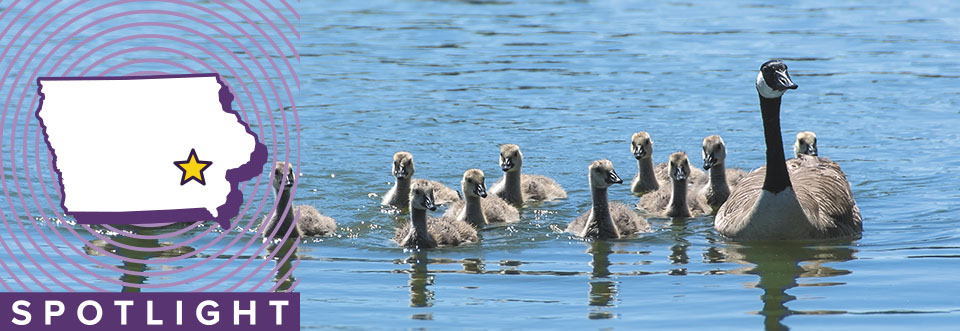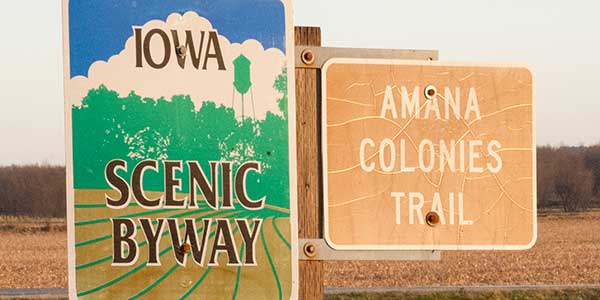
Places Welcoming You

|
Amana RV Park & Event Center Amana, Iowa |

Places Welcoming You

|
Amana RV Park & Event Center Amana, Iowa |
Sitting on the banks of the Iowa River, the vibrant Amana Colonies originated from a 19th-century German religious group. Persecuted in their home country, the Inspirationist sect discovered refuge in the fertile land of Iowa. The group founded a cluster of villages that reflected their values of communal living. Declared a National Historic Landmark in 1965, the seven Amana Colonies form an impossibly idyllic tapestry of hamlets.
Brick, stone and clapboard homes, ringed by craft stores and factories, are enclosed within a green and pleasant landscape that feels imported from another space and time. While a strict adherence to the communal lifestyle no longer holds sway (it was voted out in 1932), the colonies’ immaculately preserved streets remain an evocative place to stroll and linger. With scenic hiking and biking trails lacing the surrounding valleys, the villages provide a good launchpad for sedate rambles, bike rides and wildlife watching.
More than 500 historical buildings, each with a distinct function (dairy, church, bakery, blacksmith, etc.), constitute the seven colonies. Within each quaint landmark district, seven landmark buildings are managed by the Amana Heritage Society and are open for visits. As well as providing hands-on demonstrations and workshops, these windows to the past offer an authentically rich insight into the history and traditions of the colonies. Within the three 19th-century buildings that comprise the Amana Heritage Museum, a series of exhibits chart the origins and evolution of the Inspirationist sect and display a selection of their traditional crafts.
Also worth a visit, the Ruedy Kitchen ranks as the only intact communal-era kitchen remaining in the Amanas. With a huge hearth, dry sink and original implements, it looks exactly as it did during the colonies’ final communal meal in 1932. With its cutters, hammers, bellows, anvil and horseshoeing area, the blacksmith shop provides insight into mid-20th-century agrarian life, when small-town industry and commerce leaned heavily on the blacksmith’s skill set. Horseshoeing, printing and bookbinding demonstrations are offered at the print shop, which has a fully operational Linotype (the machine that revolutionized newspaper publishing when it was invented in 1884) and a handset printing press.
Although members of the Colonies worked hard to maintain their community, they nonetheless cultivated the arts. That creative spirit remains alive today in the Iowa Theatre Artists Company, which runs shows from April to December at its 99-seat theater in Amana.
German conviviality also prevails in the Colonies, and anyone can attend one or all of the many festivals held there throughout the year. Winterfest, Maifest, Wurstfest and Oktoberfest promise days of food and family-friendly activities.

The Amana Colonies encompass more than 26,000 acres of tranquil and distinct Iowa habitats. A popular walk/hike is the Kolonieweg (Colony Way), a three-mile trail that links the villages of Amana to Middle Amana. Starting from the colonies’ historic train depot (worth a look), it traverses grassy meadows, prairies, pastures and farmlands before coiling around the beautiful 170-acre Lily Lake, so named for the vivid display of yellow American lotus lilies that bloom during the summer. The waters and marshy recesses of Lily Lake provide sanctuary to migrating birds, herons, bald eagles, wild geese, ducks and muskrats. Walking Stick Adventures provides guided, family-friendly hikes and strolls through forests, creeks, streams, ponds and prairies, including a hike to the Iowa River Outlook.
Dotted with a number of historical landmarks, the Amana Colonies’ gravel bike routes begin in Middle Amana before separating into two distinct routes: Route A begins at the entrance to the Amana Colonies Golf Club in Middle Amana and continues on a picturesque gravel path (moderate to easy level) through native hardwood timberland for seven miles before reaching High Amana. The main sights in town include the High Amana General Store (virtually unchanged since 1857) and the Amana Arts Guild.
Also branching out from the Middle Amana golf course, the more challenging Route B heads to West Amana and loops for 17 miles through the landscapes of Grant Wood Country, where rolling hills and valleys bathed in diffused light inspired such masterworks as Young Corn, Woman with Plants and the seminal American Gothic.
Boasting the lion’s share of tourist attractions, West Amana makes for a worthy destination. There’s the legendary Walnut Rocking Chair (the largest in Iowa); Opa’s Tractor Museum, displaying agricultural memorabilia; and the Michele Maring Miller Studio and Gallery, where you can pick up an Amana landscape painting by local watercolorist Miller.

The Amana Colonies’ abiding principles of self-sufficiency (and practicality) find expression in the craft and trade shops of the Amana villages, which do a brisk trade in traditional crafts. Amana furniture, which has been built by hand since the 1850s, remains much coveted for its quality, heritage and story value. The same meticulous centuries-old processes and expert craftsmanship still prevail in the Amana Furniture and Clock Shop, where heirloom-quality furniture, clocks and home décor are well worth appreciating. Customers can also watch the craftsman at work in the viewing gallery.
Amana Colonies embodies a treasured style of rural American architecture. This design style has been neatly captured in the 1/12-scale replicas of woodworker Henry Moore’s pieces, which are on display at the Mini-Americana Barn Museum in South Amana. No detail is spared in the construction of these miniature marvels. Young ones can let their imaginations run wild as they peruse the scenes filled with more than 3,000 figures representing livestock, people, farm equipment and more.
Amana Colonies Visitors Center
800-529-2294
Iowa Tourism Office
800-345-4638